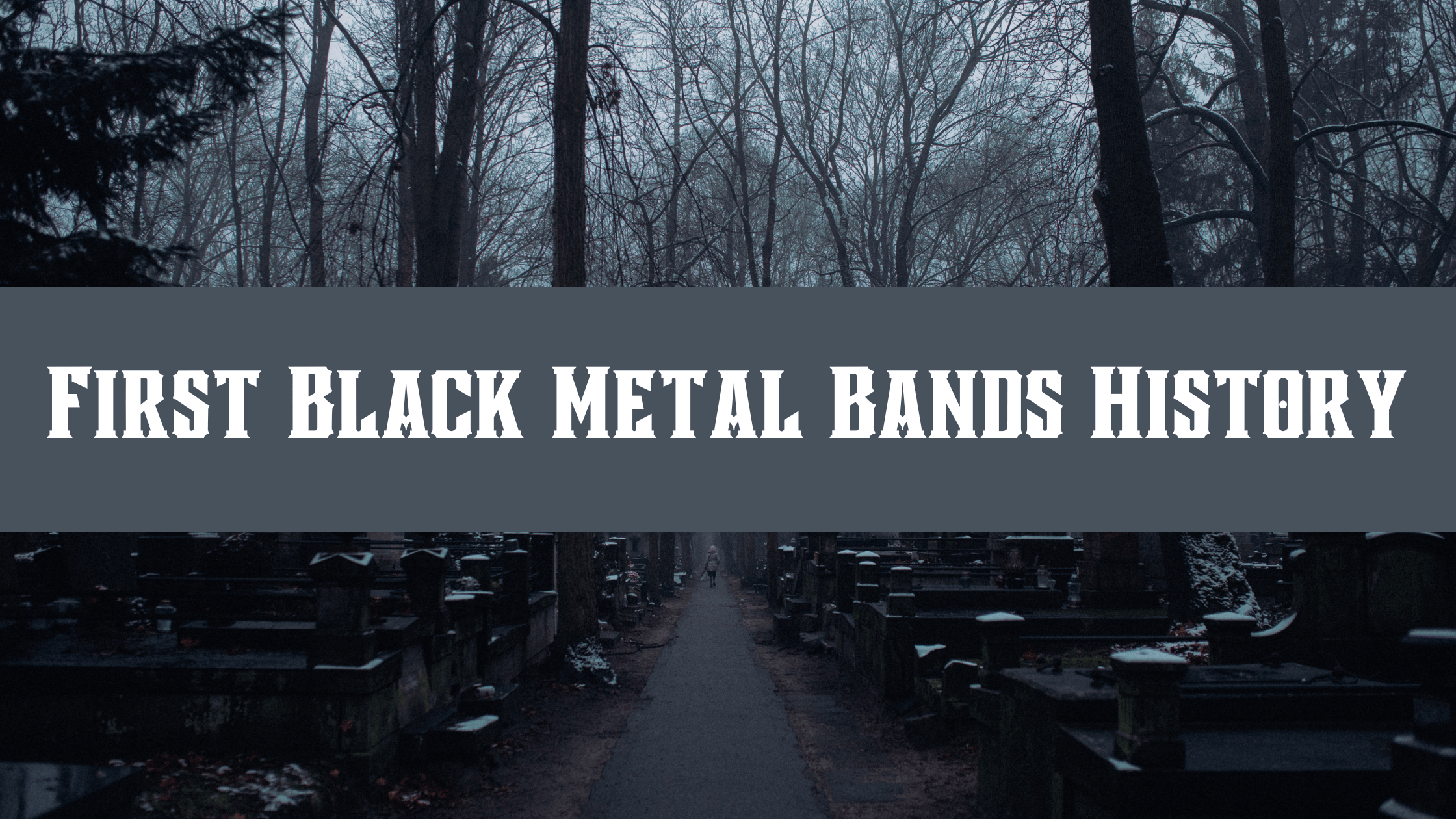In the dimly lit annals of heavy metal history, there exists a subgenre that has long fascinated and often bewildered music enthusiasts: Black Metal.
This enigmatic and controversial genre emerged from the shadows in the early 1980s, birthing a wave of dark, aggressive, and profoundly atmospheric music that would captivate and, at times, shock the world. In this exploration of the First Legends of Black Metal, we journey back to the origins of a musical movement that forever altered the landscape of extreme music.
These pioneers, often shrouded in myth and infamy, set the stage for a genre that would become an enduring and influential force in the realm of heavy metal.
From Darkness to Infamy: The Mayhem Saga
Introduction
In the shadowy realm of black metal, few bands have left as indelible a mark as Mayhem. This Norwegian juggernaut stands not only as a pioneer of the genre but also as a symbol of its extreme and controversial facets. In the first installment of our series on legendary black metal bands, we embark on a journey through Mayhem’s tumultuous history, exploring their rise from the depths of obscurity to their infamous notoriety within the metal community.
Early Beginnings
Mayhem’s inception can be traced back to the cold and enigmatic landscapes of Norway. Formed in 1984 by guitarist Euronymous (Øystein Aarseth), the band initially bore the name “Musta,” Finnish for “black.” It didn’t take long for them to adopt the more ominous moniker, Mayhem.
In their nascent years, Mayhem drew inspiration from the emerging thrash and death metal scenes. Bands like Celtic Frost and Bathory left a profound mark on their musical direction. This period of experimentation and exploration laid the foundation for the darker and more extreme sound that would define black metal.
Euronymous and Dead
Two figures loom large in Mayhem’s early history: Euronymous and Dead. Euronymous, the band’s guitarist, was not only a mastermind behind Mayhem’s music but also a key figure in the burgeoning Norwegian black metal scene. His vision and ambition played a pivotal role in shaping the band’s early sound.
However, it was the arrival of Dead (Per Yngve Ohlin) that would truly push Mayhem into the abyss. Dead’s haunting lyrics and tormented vocals introduced a level of darkness and intensity previously unseen in metal. Tragically, Dead’s personal struggles culminated in his suicide in 1991. The aftermath of this event would send shockwaves through the band and the entire black metal community.
Debut Album – “De Mysteriis Dom Sathanas”
Mayhem’s ascent to infamy reached its zenith with the release of their iconic album, “De Mysteriis Dom Sathanas,” in 1994. This magnum opus, featuring the contributions of Attila Csihar on vocals and Hellhammer on drums, is a dark and haunting masterpiece. Attila’s otherworldly voice and Hellhammer’s relentless percussion created an atmosphere of malevolence and chaos that defined the album.
“De Mysteriis Dom Sathanas” was not merely a musical endeavor; it was a summoning of the infernal. The album remains a cornerstone of black metal, a testament to Mayhem’s ability to conjure the darkest of sonic forces.
Controversies and Notoriety
But Mayhem’s story is not just one of musical triumph; it’s also marred by controversy and notoriety. The band became entangled in a series of church burnings in Norway during the early ’90s, which sent shockwaves through the nation and the global metal community. These acts of arson, attributed to members of the Norwegian black metal scene, including Euronymous, thrust Mayhem into the spotlight of infamy.
Intriguingly, it was the band’s association with these events that cemented their place in the annals of black metal history. The controversies surrounding Mayhem, from the macabre stage performances to the darker aspects of their personal lives, only added to their mystique.
Mayhem’s journey from their humble beginnings to their tumultuous and notorious existence is a tale of darkness, tragedy, and unrelenting artistic expression. In the next installment of our series, we will delve deeper into the enigmatic world of black metal, exploring the iconic band, Burzum, and the enigmatic figure behind it, Varg Vikernes.
Darkthrone: Pioneers of the Norwegian Black Metal Scene
Introduction
In the unforgiving landscape of Norwegian black metal, where darkness and chaos reign supreme, one band stands as a pioneering force that helped define the genre’s essence. Darkthrone, a name that invokes reverence among metalheads, emerged as a beacon of raw, unfiltered black metal. In the third part of our series on legendary black metal bands, we delve into the mystique of Darkthrone and their profound influence on the genre.
Formation and Early Works
Darkthrone’s journey into the heart of Norwegian black metal began in 1986 when the band was formed under the name “Black Death.” The original lineup included Gylve Nagell (Fenriz) and Ivar Enger (Zephyrous). In the early years, the band explored death metal, releasing their debut album, “Soulside Journey,” in 1991. However, it was their transformation into the black metal realm that would etch their name into history.
The release of “A Blaze in the Northern Sky” in 1992 marked a seismic shift. Darkthrone abandoned their death metal roots and embraced the raw, primitive, and uncompromising sound that would become synonymous with Norwegian black metal. Albums like “Under a Funeral Moon” continued to solidify their position as purveyors of darkness.
Musical Evolution
Darkthrone’s musical evolution is a testament to their restless spirit and willingness to push boundaries. They didn’t confine themselves to the traditional black metal formula. Instead, they explored punk and crust influences, infusing their music with a raw, DIY ethos. Albums like “Transilvanian Hunger” exemplify this evolution, with its lo-fi production and hypnotic riffs that resonate with the black metal purists.
“Panzerfaust,” another milestone in their discography, showcased their ability to seamlessly blend black metal with elements of punk and traditional heavy metal. Darkthrone’s willingness to experiment while staying true to their black metal roots made them trailblazers in the genre.
Impact on the Genre
Darkthrone’s impact on the black metal genre cannot be overstated. They helped shape the Norwegian black metal scene, which would go on to produce some of the most infamous and influential bands in the genre’s history. Their uncompromising approach to music, aesthetics, and ideology set the standard for a new generation of black metal artists.
The band’s influence extends far beyond their native Norway. Darkthrone’s music resonated with underground metal scenes worldwide, inspiring countless bands to embrace the DIY ethos and create raw, authentic black metal. Their dedication to the genre’s core principles, including rebellion against mainstream conventions, added to their legendary status.
As we reflect on the pioneering spirit of Darkthrone, we recognize their enduring legacy in the annals of black metal history. Their ability to evolve while staying true to the genre’s primal essence cements their status as true pioneers. In our next installment, we will continue our exploration of the genre by delving into the enigmatic world of black metal subgenres and regional variations.
Immortal: Unveiling the Icy Aggression
Introduction
In the frostbitten realm of black metal, where darkness and chaos intertwine, few bands have left an indelible mark quite like Immortal. Hailing from Norway, the birthplace of black metal, Immortal emerged as an iconic force, melding icy atmospheres with relentless aggression. In this exploration, we delve into the saga of Immortal, a band that carved its name in the annals of black metal history.
Formation and Early Years
The saga of Immortal began in the late 1980s, in the heart of Norway’s black metal crucible. Formed by guitarist and vocalist Abbath (Olve Eikemo) and guitarist Demonaz (Harald Nævdal), the band embarked on a journey that would reshape the very landscape of black metal. Together with drummer Armagedda (Roger Moe) and later, bassist Apollyon (Ole Jørgen Moe), Immortal’s initial lineup was forged in the fires of musical experimentation.
Musical Evolution
Immortal’s musical odyssey can be likened to a blizzard that slowly transforms into an unrelenting blizzard of epic proportions. Their early works, including “Diabolical Fullmoon Mysticism” and “Pure Holocaust,” encapsulated the raw, unfiltered essence of black metal. Yet, it was their evolution towards a more refined and epic style that set them apart.
Albums like “At the Heart of Winter” marked a turning point, introducing elements of melody and grandeur into their sonic arsenal. Immortal’s sound evolved without losing its primal ferocity, exemplifying a musical journey that embraced both tradition and innovation. “Sons of Northern Darkness,” with its anthemic qualities, stands as a testament to their mastery.
Visual Aesthetics
The visual identity of Immortal is as distinctive as their music. Corpse paint, a signature of black metal, took on an otherworldly aspect with Abbath and Demonaz. Their sinister and warlike stage presence, complete with leather and spikes, conjured a powerful image that mirrored the icy landscapes of their homeland. Immortal’s appearance became an integral part of their artistic expression, serving as a visual gateway to the realms they conjured through music.
Impact and Legacy
Immortal’s impact on the black metal genre reverberates to this day. Their unique blend of aggression and epic atmospheres influenced a generation of black metal artists. Their enduring legacy extends beyond their native Norway, inspiring bands worldwide to explore the boundaries of the genre.
Immortal’s music continues to resonate with both seasoned black metal aficionados and newcomers alike. Their ability to channel the frozen landscapes of Norway into sonic landscapes is a testament to their artistry. As we traverse the icy plains of Immortal’s discography, we uncover a band that not only shaped black metal but also left an indelible mark on the global metal landscape.
Another Black Metal Legend: Immortal
Introduction
In the frostbitten realms of black metal, where sonic extremity meets frozen landscapes, few bands have left an indomitable mark like Immortal. Hailing from Norway, the very heart of black metal’s birth, Immortal stands as an iconic band in the genre’s history. Their music is a unique amalgamation of icy atmospheres and unrelenting aggression, creating an auditory journey that is as chilling as it is captivating.
Formation and Early Years
The tale of Immortal began in the late 1980s in Norway, a hotbed for black metal’s burgeoning culture. Founded by guitarist and vocalist Abbath (Olve Eikemo) and guitarist Demonaz (Harald Nævdal), Immortal embarked on a journey that would reshape the very fabric of black metal. Together with drummer Armagedda (Roger Moe) and later, bassist Apollyon (Ole Jørgen Moe), Immortal’s initial lineup was cast amidst the crucible of musical experimentation.
Musical Evolution
Immortal’s musical odyssey can be likened to a tempestuous blizzard that gradually transforms into an all-encompassing blizzard of epic proportions. Their early works, including “Diabolical Fullmoon Mysticism” and “Pure Holocaust,” encapsulated the raw, unfiltered essence of black metal. Yet, it was their evolution towards a more refined and epic style that set them apart.
Albums like “At the Heart of Winter” marked a turning point in their career, introducing elements of melody and grandeur into their sonic arsenal. Immortal’s sound evolved without relinquishing its primal ferocity, exemplifying a musical journey that embraced both tradition and musical innovation.


